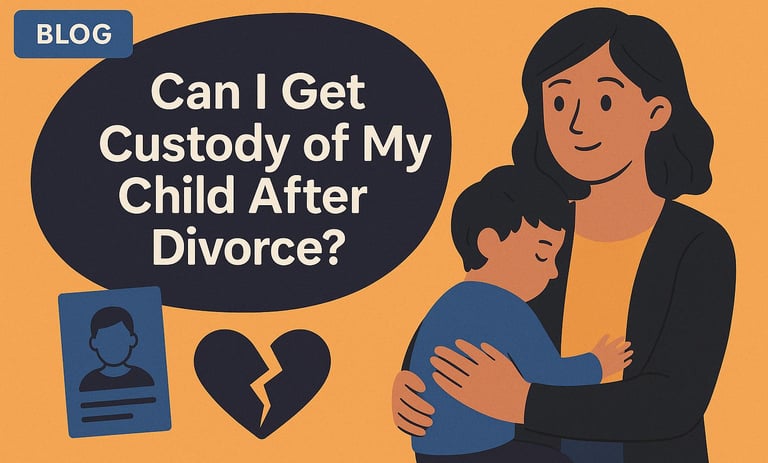Can I get the custody of my child after divorce?
This article explores the legal, emotional, and practical aspects of securing child custody after divorce. It outlines custody types, their distinctions and decision-making factors in court.
FAMILY LAW
Prajul
6/24/20253 min read


Divorce is a tremendous life-altering decision that impacts a person emotionally, financially, and legally- not just the couple involved but also their families (particularly their children). Amongst the various difficult decisions that a divorcing couple has to make, the custody of the child is often the most disputed and emotionally charged decision to make. Naturally, both parents want what is best for the child, but they also fear losing time, influence, weakening their bond or connection with their children after the divorce; therefore, they hope to get custody of their child to maintain a strong relationship with them.
However, getting custody of their children isn’t a straightforward decision, as child custody is determined by multiple legal standards, parental behaviors, and what the court deems in the best interest of the child.
Understanding Child Custody:
Child custody refers to the legal arrangement to make certain decisions related to the physical care and upbringing of the child. This whole arrangement has been divided into two categories:
Legal custody: This determines who gets to make important decisions about the child’s upbringing. This includes their education, healthcare, religion, etc.
Physical custody: This determines with whom the child gets to live primarily.
Who Can Apply for Custody?
Either one of the parents can file for custody during the divorce procedure or even afterwards. Sometimes legal guardians or even grandparents can file for custody if the child’s welfare is at stake; however, priority is given to the biological or adoptive parents.
How court decide on granting custody?
The court makes this decision on what the court deems as the best interest of the child. They come to a final decision only after considering several factors:
Child’s Age and Needs: Younger children often require more hands-on care, attention and nurturing.
Parental Capability: this involves evaluating each parent’s emotional stability, physical health and financial ability and resources, in order to determine their potential ability to support their child.
Stability: ability to maintain a stable environment
History of Caregiving: Which parent was originally responsible for looking after the child’s day-to-day tasks
Child’s Preference: with whom the child feels more comfortable and attached with.
Parental Conduct: how each parent conducts themselves in front of the child.
Willingness to Cooperate: Who amongst the parents is willing to support the child’s relationship with the other parent?
Type of custody outcomes:
After considering and evaluating all the above-mentioned factors, the court may come to a conclusion regarding an arrangement that is in the best interest of the child. The various types of arrangement are:
1. Joint Legal and Physical Custody: The child lives with both parents for almost an equal amount, and both parents have an equal responsibility.
2. Sole Custody with Visitation Rights: one parent is granted full custody and the other may be allowed visits, supervised or unsupervised.
3. Bird’s Nest Custody: the child remains in one place and the parents alternate living there.
4. Split Custody: In case of multiple children, each parent gets custody of different children. This is a rare and unlikely outcome.
Mothers vs. Fathers: Who Gets Custody?
In the past, mothers were often favored, especially in cases involving younger children. Nowadays, courts prioritize gender neutrality and base their decision in accordance with the child’s best interest.
Parental gender no longer plays a favorable role as long as a parent can provide a stable and nurturing environment for the children.
Custody and Visitation Rights in India
In India, child custody is governed by different personal laws:
Hindu Law: Under the Hindu Minority and Guardianship Act, 1956, and the Guardians and Wards Act, 1890, custody decisions are based on the child’s welfare.
Muslim Law: Typically grants the custody of the child to the mother until a certain age, with the father acting as his/her natural guardian.
Christian and Parsi Law: Courts decide custody through the Guardians and Wards Act, which applies universally when personal laws are unclear or inapplicable.
Indian courts often award guardianship to one parent and custody to the other or create a mutual arrangement through mediation.
Shared Parenting and Modern Trends
The courts are now willingly giving higher preference to the concept of co-parenting and shared custody arrangements as they believe it is in the best interest of the child if both parents gets actively involved in the child’s life.
Modifying Custody After Divorce
Custody arrangements are not always permanent and can be modified with time under certain circumstances, such as if one parent decides to relocate or remarry or if concerns are raised regarding their capability to fulfil their parental duties. A parent can also seek modification of the custody if the other parent exhibits signs of neglect or is unable to perform their responsibilities of taking care of their child any longer.
In conclusion, yes, it is possible that you can get custody of your child after divorce, regardless of whether you’re the father or the mother of the child. However, this is not guaranteed automatically as you must first need to prove to the court and demonstrate time to time that you’re capable enough of providing a secure, stable, nurturing and loving environment for your child on your own. The main goal of these arrangements is to ensure that the child’s welfare is promoted and to promote healthy development even after the divorce.
